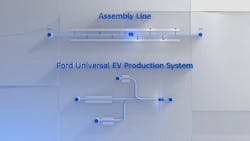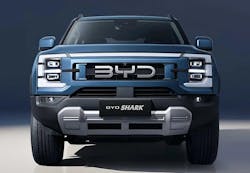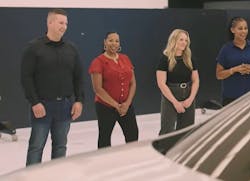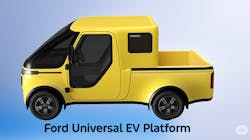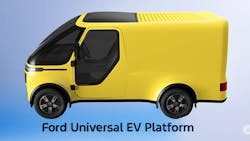Ford’s Model T(esla) EV: The Minitruck Tesla Should’ve Made
Ford hired Tesla dudes
Frunks, Castings, Zonal Wiring
No Mavericks there.
Ford Motor Company hosted a livestream on August 11, 2025 to announce an allegedly revolutionary low-cost EV platform, one designed for ultra-low cost to compete head on with the likes of Chinese EV behemoth Bring Your Own Dreams (BYD), whose worldwide EV sales now surpass those of Tesla.
Jim Farley, Ford’s CEO, reset the company’s EV direction a bit over three years ago, after realizing Ford’s portfolio, primarily consisting of the Mach-E and Ford Lightning, wasn’t competitive with the offerings of BYD and other Chinese vehicles. At the start of the livestream, CEO Farley announced their modern “Model T moment” would be a battery EV (BEV) minitruck built on a universal platform supporting other vehicle types.
As a point of reference, this past March, BYD unveiled their Shark mini-truck (Fig. 1), available in either plug-in hybrid EV (PHEV) or BEV variants, for $7,000 to $9,200 in China. Yeah, tariff that one at 100% and the U.S. working class still gets a minitruck for under $20k.
We’ve also seen Slate announce a U.S.-made minitruck this past April (Fig. 2) challenging low-cost EV thinking with a barebones platform that included hand-crank windows and a BYOB (Bring your own Bluetooth) sound system to get the pricing under $20,000 — factoring in the $7,500 Federal EV rebate that the current Congress abolished as of this coming September 30th.
So, an Indiana-made minitruck from a cost-focused startup, with an ex-Ford Ranger, farmtruck-driving CEO at the helm, goes for $27,500. To give her credit, she did come out of Stellantis, iirc.
Ford’s livestream was substantially a feel-good PR effort designed to highlight the $2B being invested in the local economy, with an additional $3B investment in their lithium-iron-phosphate (LFP) EV-battery factory in Marshall Michigan, creating 1,700 jobs.
“Ford is licensing from China-based Contemporary Amperex Technology Co. Ltd. [CATL] the product design and manufacturing process for lithium-iron-phosphate batteries. That technology was developed in the United States but industrialized in China and is less expensive than batteries found in most EVs on the road in the United States today.” — gmtoday
[Here’s an aside for you: LFP will get squeezed by falling nickel-manganese-cobalt-aluminum (NMCA) and lithium manganese-rich (LMR) prices, plus the threat of sodium is around the corner, so LFP is being forward priced. It may not be sustainable or profitable, though; hopefully Ford has done their own due diligence. LMR looks poised to eat LFP’s lunch, as will sodium in grid storage — see my piece here for more details]
More than half the livestream’s time was spent by talks from Kentucky’s governor, as well as UAW representatives on how safe the manufacturing environment would be, reducing worker injuries and fatigue. Mitch McConnell and Rand Paul were conspicuously missing.
The unveiling of Ford’s new minitruck was not to be, though I did do a screencap of the most important feature — it, sadly, has a hood (Fig. 3), a vestigial, useless snout left over from ICE. You see, trucks have beds and can have truck caps, tonneau covers.
Features that were disclosed for the $30,000 minitruck platform, available in 2027, included:
- A “frunk”
- Unicastings (“Gigacasting” in Tesla parlance) using IDRA’s high tonnage press technology
- Zonal wiring strategy to reduce copper usage (4,000 feet is claimed)
- Multiple body types on a common “skateboard”
- Ford’s BlueCruise ADAS
- Mobile power-plant capability (V2H, V2G)
- “The best part is no part” — Doug Field, Chief EV, Digital and Design Officer, Ford Motor Co., Aug 11 Livestream
Gee, this sure sounds like a Tesla, doesn’t it? Right down to using Elon’s mantra on the best component for the job. They don't appear too shy about appropriating a lot of Tesla stuff. Perhaps the two companies have reciprocal patent agreements in place where it’s open season?
The Innovation Zero Initiative
There’s a reason for this cloning of Tesla’s innovations and biases, of course. Looking at LinkedIn for their work histories, both Field and Alan Clarke appear to have been poached from Tesla, or maybe left to form the Skunkworks group at Ford during the alleged internal Cybertruck kerfuffle with Musk, when a big part of the team allegedly thought it was a really stupid product idea.
Field spent some time at Apple on “Special Projects” before joining Tesla (I’m guessing Apple Car), so putting that piece of the puzzle together with his title seems to indicate that this “low-cost” Ford EV is a trojan horse for Ford subscription services much like Apple Car. Clarke has been involved from Model S though Model Y, including working on Cybertruck and Roadster II prototyping.
But do Apple and Tesla know how to build inexpensive cars and trucks? Anything? I’m not so sure....
This Ford “Model T[esla]” EV was supposed to be a low-cost EV platform to compete with the Chinese (namely BYD). However, Field makes a rather disturbing disclosure of his intentions with his Henry Ford quote interpretation in the Livestream:
“The Model T was affordable not because it was a thrifted version of other cars that were out there; it was the result of brilliant minds taking fundamentally new approaches to old problems.” [my emphasis, because Tesla did it first, afaik].
Meanwhile, their major competitor, BYD, ackshually[sic] is a thrifted version of other cars. Hello, kids? BYD Shark, your competitor, is $9,200 in China and you’re at...$30,000. FAIL.
What it looks like is that the Skunkworks effort imported team members from Tesla, Rivian, Canoo, etc., to build what Elon would not let them do — a minitruck. There’s zero innovation in the approach that’s apparent to me. All of it appears to be appropriated from Tesla, including the notion of bolting the instrument panel and seats to the top of the battery casing and lifting it into the vehicle from the bottom (“structural battery”). Ah, the joy of California’s total disregard for non-compete agreements.
What the Frunk?
They’re including a frunk, something Lightning appropriated from Tesla as well. My Bolt EV doesn’t have a frunk and I got a parking spot right in front of The Schnitz after a Model 3 gave up on squeezing into that spot for an easy walk to The Symphony.
While it was a small team, it doesn’t look or seem to function like a real Skunkworks. Farley is known to have signed off on all major decisions, like maybe “got to have a frunk,” “has to seat five people,” “more room than a RAV4,” etc. A real Skunkworks is “make it 20 grand and a pickup truck, call me when it’s done.” “Make it fly Mach 3 and at 80,000 ft., and make sure it has a frunk,” said no one.
The Bolt EV was done by the 180-person Daewoo team in South Korea — far enough away to where GM’s VP, Bob Lutz, couldn’t ruin what turned into a perfectly packaged little car that GM is now ruining.
The Assembly LINE
The marketing hype everyone is picking up in popular media is that this manufacturing team has innovated and come up with a TREE instead of a LINE for building this EV (see image at top). I call BS as a former assembly-line worker during my summer break to pay for university.
We had assembly-line trees in the truck plant where I worked (I was a few stations down from the booth where “Laverne and Shirley,” the first ever robots in the plant, were painting pickup truck beds, with me attaching a wide chrome trim plate to the back of the tailgate. Once in a while, I’d zone out and put the plate on upside down and they couldn’t open the tailgate further down the line, lol).
We had a body line, a chassis line, and a trim line (where instrument panels and dashboards were assembled) — a TREE — and they all came together at a couple of points, first marrying the body and chassis, then a counterweighted arm was used to insert the dash through the front door opening. OK, so the Skunkworks people pilfered Tesla’s structural battery concept, which has the seats and instrument panel bolted to the top of the battery box and that assembly came into the vehicle from the bottom. Did you hear? BYD Shark is $9,200 in China.
The Way They Should Have Done It
First of all, the skateboard pretty much produces a flat floor, including the drive units, if that’s a design constraint. They brag about this Tesla talking point in the livestream. It means that the space under the hood of an EV is wasted space other than as a crash crumple zone. “The best part is no part” — so, ditch the frunk. Sorry Farley...Skunkworks...you have no say about keeping tradition or your market feels.
The optimal way to package passengers is the way vans and VW buses have done it for decades — push the passengers as far forward as possible. Two or three bags of mostly water in one row of seats. Then put a pickup bed behind them, one that’s now lengthened from the three-and-a-half-foot vestigial appendage to a full six-and-a-half footer because of the three feet gained by ditching the frunk. Canoo did this.
That smaller cabin means less material, one less row of seats, no extra door openings to reinforce, and creates an environment where all wiring is in the instrument panel, with a connector to the BMS, charger, drive unit, and DC-DC converter. See? I saved 4,000 ft of wiring without buying a smart node and lightened the vehicle by a couple hundred pounds. That’s the base model (Fig. 4).
Extended cab? Sure (Fig. 5). Note the wires. I added 25 feet of 18-gauge wire to the taillights and license plate lamp. No smart nodes or zonal wiring.
Crew cab? NO, Jim. It’s a minitruck — go buy a Lightning.
Three-row SUV? Sure, no bed, so why not. Van? Absolutely (Fig. 6). Now we don’t need the three-row model; an inventory and supply-chain cost reduction.
Hand-crank or pop-open windows, no center display, DIN slot for a radio. Base truck. $20k. 80-kW motor. 2750 lb. Slate has the right idea, but they have a snout...that’s extra weight, extra material, extra length that robs the bed length. It’s a truck. For the masses. Add-on options that customers spec, but base has gotta be cheap. Just like my Dad’s $2,800 three in the tree, 6 cyl, 1971 C10. It was $1k less than a V8 car. This truck of mine (and Google Gemini) can compete in world markets.
You want power windows? BlueCruise? 200 hp? Trailer hitch? 70% gross margin RPO codes...build your truck vs. us telling you what you want and forcing you to buy a $95,000 pickup truck.
The upper middle class can buy a truck for $39k, but the poors need that three in the tree, $20k base truck. The poors can barely make rent, yet the Ivory Tower occupants in Dearborn have busted out the calculators for $39.95/month for subscriptions. By the way, “cost overrun doesn’t matter on the Ford Model Tesla — we'll pay for it with software-defined-vehicle modes, and other trash that doesn’t get working people to their $7.25/hour jobs” is what I imagine is the thinking.
I think you lost the plot on this one, Tesla and Apple kids at Ford. I think it’s epic fail because of a complete lack of imagination and innovation, allowing the CEO to lead/gate a Skunkworks, and a failure to CPI that baby to $15k. It appears to me like this effort came out of Ford Skullworks, not Skunkworks, and, if so, I think it stinks.
Andy's Nonlinearities blog arrives the first and third Monday Tuesday of every month. To make sure you don't miss the latest edition, new articles, or breaking news coverage, please subscribe to our Electronic Design Today newsletter. Please also subscribe to Andy’s Automotive Electronics bi-weekly newsletter.
About the Author
Andy Turudic
Technology Editor, Electronic Design
Andy Turudic is a Technology Editor for Electronic Design Magazine, primarily covering Analog and Mixed-Signal circuits and devices. He holds a Bachelor's in EE from the University of Windsor (Ontario Canada) and has been involved in electronics, semiconductors, and gearhead stuff, for a bit over a half century.
"AndyT" brings his multidisciplinary engineering experience from companies that include National Semiconductor (now Texas Instruments), Altera (Intel), Agere, Zarlink, TriQuint,(now Qorvo), SW Bell (managing a research team at Bellcore, Bell Labs and Rockwell Science Center), Bell-Northern Research, and Northern Telecom and brings publisher employment experience as a paperboy for The Oshawa Times.
After hours, when he's not working on the latest invention to add to his portfolio of 16 issued US patents, he's lending advice and experience to the electric vehicle conversion community from his mountain lair in the Pacific Northwet[sic].
AndyT's engineering blog, "Nonlinearities," publishes the 1st and 3rd monday of each month. Andy's OpEd may appear at other times, with fair warning given by the Vu meter pic.
